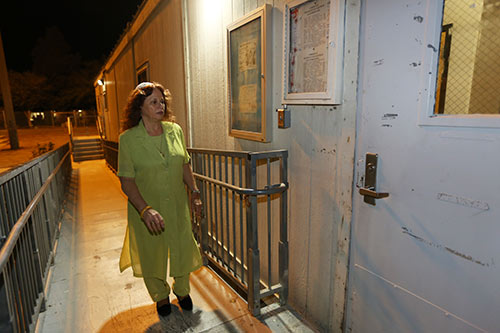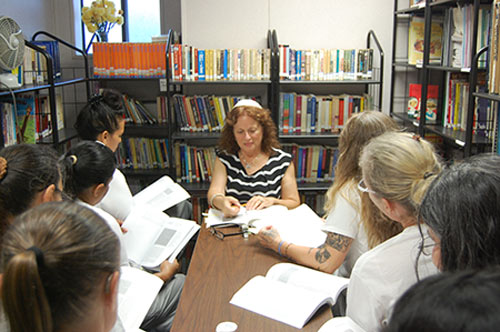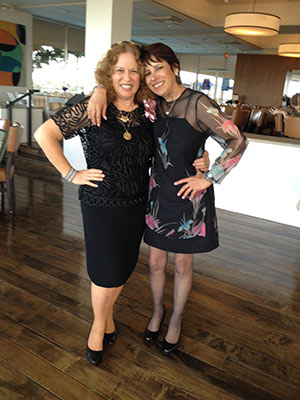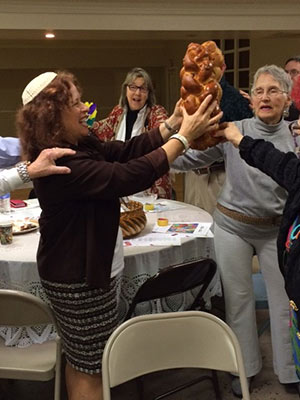American View
Personality
Rabbi Hamrell Takes Healing Beyond the Prison Wall

The phone rang at 10 p.m. that Friday in December a few years ago, long after Rabbi Miriam Hamrell’s children and grandchildren had left her condo in Marina del Rey, Calif. Hamrell and her husband, Chuck, were still relaxing at the Shabbat table with two houseguests, enjoying the muted roar of the Pacific Ocean, which could be heard through the sliding glass door of their beach-level porch.
It was Vicki Kaufman on the line. She had been arrested, again, and needed to be bailed out.
Hamrell set out from her condo and drove 40 minutes to the Van Nuys jailhouse. It was 2 A.M. by the time she posted the $2,000 bail and signed the forms required for Kaufman’s release. When the two women got into Hamrell’s car, both burst into tears.
“Vickileh, what are you putting me through?”
Hamrell brought Kaufman home with her and settled her into one of her guest rooms.
This kind of act is not unusual for Hamrell, 69, a rabbi whose mission appears to be to dispense love to those most in need. She shows that love in the most concrete ways—from hugging each of her congregants on Shabbat morning to showing up in sketchy neighborhoods in the middle of the night, like she did for Kaufman, whom she had first met when she taught her Talmud in prison.
That impulse has led to a fascinating ministry for Hamrell, who was born in Israel to Holocaust survivors and served in the Israeli Army. In 1969, at the age of 19, she moved to the United States with her family and, three decades later, was ordained at the age of 53 at the nondenominational Academy for Jewish Religion, California.
Today, she serves as the rabbi of Ahavat Torah, a nondenominational congregation that meets in a church on Los Angeles’s Westside and serves 105 members, mostly middle-aged and senior adults. Hamrell hosts weekly classes and potlucks in her home, and she and her congregants volunteer with veterans, in domestic violence shelters and with the homeless—some of whom have joined Ahavat Torah.
Every other Tuesday for the past 13 years, Hamrell has been volunteering at the California Institution for Women in Corona, 50 miles east of Los Angeles. There, she teaches Talmud and offers spiritual counseling to inmates. She also involves herself in their lives after their incarceration: She regularly visits the courthouse, parole offices and a home in the heart of Los Angeles’s gang territory where female ex-convicts live for a few months after they are released. She once flew across the country to cook and care for a wheelchair-bound woman, a former student in her Talmud class who spent 29 years in CIW for killing her abusive husband, a policeman.

On a recent Tuesday visit to CIW, four security doors clank behind Hamrell, who is just over 5 feet tall, before she emerges into the sunny yard of the 126-acre facility set among strip malls and housing tracts at the foot of the lofty San Gabriel Mountains. Mount Baldy, the highest peak in Los Angeles County, is visible from the prison yard, beyond the wire fencing and guard towers that Hamrell says are uncomfortably evocative of the concentration camps her parents survived.
Several of the prisoners, on their way to dinner from work assignments or classes, wave and call out to the rabbi as she is driven in a golf cart across the prison campus. With its squat buildings scattered amid cracking asphalt and patches of scraggly brown weeds, it looks like a run-down summer camp.
The beige, prefabricated unit of the religious services department houses a shared chapel and offices for the Jewish, Catholic, Protestant, Muslim and Native American chaplains as well as other volunteers.
At 5:45 P.M., after dinner, eight women, all dressed in white and gray, file into the building’s beit midrash, which is lined with shelves of donated books and just big enough to fit a folding table and chairs.
“The Talmud is full of beautiful arguments for the sake of heaven,” Hamrell says, explaining her decision to teach Talmud to the women. “They learn that if I don’t argue to put you down, to put your character down, to put your soul down, if it does not become personal, we can dialogue forever and stay on the topic.”
Many of the women, of all ethnicities and ages, come from abusive relationships. As they struggle to defend their space in their current confinement, she says, the Talmud offers a different model of communication.
The rabbi and students grasp hands for a meditation that begins the learning session.
“Breathe,” Hamrell instructs the group. “Focus on how blessed we are to be able to study words of Torah together. On how blessed we are to keep our hearts open just wide enough so we can allow the ideas and opinions of others to penetrate our heart.”

The women open their books, Swimming in the Sea of Talmud, to the section on Kiddushin 42b, which presents the case of a person who sends an item with a deaf-mute or a child that ends up igniting a damaging fire. The question arises: Who is responsible—the carrier or the person who sent him? The women take turns reading the text in English, then a commentary. They launch into a deep discussion about the reaches and limits of responsibility, moral and legal liability for one’s actions and understanding how these actions can affect others.
Sitting next to Hamrell is Laura, who is serving a 21-year sentence for bank robbery. Her arms are covered in tattoos—including a few small swastikas, symbolic of the fact that she was raised in a family of neo-Nazis.
“At first, I hid my background from Rabbi Miriam, but after she told us about her father and the Holocaust, I revealed my background,” says Laura, 47, who asked that her last name not be used. She says she started coming to Jewish services and classes after a close friend in the prison revealed she was Jewish. Laura says that studying Judaism has made her a better person. She hopes to convert.
“One thing prison gives you is time to think, time to be a philosopher,” Hamrell says. “We make ourselves do this in [the month of] Elul or on Yom Kippur. We give ourselves time to reflect. Inmates have that every day, all year long.”
Laura is not the only non-Jew exploring Judaism in prison. Because the prison doesn’t document the religious affiliations of its inmates, it’s hard to say how many of the 1,900 women at CIW are Jewish, according to Rabbi Moshe Halfon, who has been the full-time Jewish chaplain at CIW since 2006. He oversees the kosher meal plan, runs prayer services, teaches Hebrew and text studies, and coordinates the Jewish volunteers, including Hamrell.
He says about 20 women are currently on the kosher meal plan and around 30 rotate through classes and services, with more showing up for events like the Passover seder, Simchat Torah dancing or a Purim party. A fair number of those attending the events are not Jewish, he says, noting that he has conducted a few adult bat mitzvahs in prison as well as conversions with a beit din (a Jewish court) and a virtual mikvah ceremony.
Halfon describes Hamrell as one of his most dedicated volunteers. “Rabbi Miriam is unique because she offers a powerful role model as a woman,” he says. “The women connect with her.”
One of those who continues to connect with Hamrell is Vicki Kaufman, 62, whose distress had roused Hamrell to bail her out of jail in the middle of the night. Kaufman, who was one of Hamrell’s students in prison, is now a member of her congregation, along with a handful of other ex-inmates.
“Something happened to me when I saw her,” Kaufman recalls of the first time she met Hamrell at Sukkot services in prison in 2011. She had recently been incarcerated. “She came and read Torah, and something about her embraced me—her warmth and her patience and her radiance.”

Kaufman, a documentary film researcher who grew up in the Fairfax area of Los Angeles, had been prescribed the anti-anxiety drug Ativan when she was in her 50s. She skidded into addiction and, ultimately, was stealing to feed her habit, which landed her in jail. Hamrell has stood by Kaufman through several relapses and incarcerations. Now, Kaufman has been clean for two years. She has steady work in her field and talks to Hamrell every day.
“I felt so guilty and so ashamed and so disgusted with myself,” Kaufman says. “I wasn’t raised like this.” But, she adds, “Rabbi Miriam saw things I didn’t see in myself. She gave me confidence.”
Most of the time, Hamrell doesn’t know—or want to know—what crimes the women committed or how long they will be incarcerated. Such knowledge, she says, is simply too much for her to carry and sometimes makes it difficult to forge a bond with a particular inmate.
One of her current Talmud students, a Jewish woman, last year admitted that she is incarcerated for molesting her own daughter. While Hamrell has found empathy for murderers, she says she is repulsed
by someone who would hurt her
own child.
“I wish I didn’t know that story,” Hamrell acknowledges, “because with all the open heart that I had for her, now I don’t even want to look
at her.”
Despite these occasional obstacles, she makes no apologies for the lengths she goes to to support these women.
“They have to pay for what they have done in their moment of insanity, but their neshama is good,” Hamrell says, using the Hebrew term for soul. “I really believe that our neshama can never be soiled. It was given to us by God when we took our first breath at birth, and that little candle is always burning within. How large the flame is, that is up to us.”
Hamrell is acutely attuned to life’s fragility. When she was almost 17, her mother, Shoshana Lefkovits, revealed that her father, Yirmiyaho Lefkovits, with whom she was very close, was not her biological father. Her birth father had left when she was a year old. He had been living 15 minutes away in Petach Tikvah but had never reached out to her.
After she found out, Hamrell isolated herself in her room for two weeks, ultimately concluding that the man who raised her was her father because of the love and concern he showed her.
“I look at my ladies and I see that it could have been me,” Hamrell says of her prison students. “The difference is, I had my father. These women have no one to protect them.”
Hamrell’s father, a school principal who was Orthodox, also gave her a deep love for Judaism. She wanted to be a rabbi (not an option for a woman when she was growing up in the 1950s and ’60s) or a teacher. But her father set her on a more practical path. She trained and served as a mechanical draftswoman in the Israeli Army and was part of the team that designed the Merkava, the first Israeli tank.
After emigrating from Israel, Hamrell started taking classes at Santa Monica College. When she married Chuck Hamrell, a medical student at University of California, Los Angeles, in 1971, she left school to work in drafting to put her husband through school. When she got pregnant with the first of their three sons, she decided to take psychology classes in child development at the University of Judaism in Los Angeles (now American Jewish University). She earned her B.A. in Hebrew Letters from the University of Judaism in 1995, and then enrolled in the school’s rabbinic ordination program—she was one of two women in her classes. But ordination required a year in Israel and two years in New York, which felt like an impossibility for her with three children and a husband who by then had a thriving medical practice in Los Angeles. Instead, she got her master’s in Jewish education in 1997 and became the principal of the Hebrew school at Temple Akiba in Culver City.
But she didn’t give up her dream to become a rabbi. In 2003, Hamrell and two other women were the first rabbis to be ordained at the Academy for Jewish Religion, California. She was hired by a small group of families who had recently left another congregation to form Ahavat Torah. She figured she would lead the congregation for seven years, then retire. That was 15 years ago, and Hamrell is still loving every minute of it, she says.
Friday night and Saturday morning services at Ahavat Torah are song-filled and punctuated with dancing and hugs—Hamrell loves to dance with her congregants, with her husband, with her grandchildren, by herself. She includes a meditation, Torah study and a midrash that focuses on character development and ethical living. Every Shabbat morning service is followed by a potluck lunch.
“She always seems to have time to spend,” says Renee Schwartz, 60, a child psychologist who has attended Ahavat Torah for 10 years and chairs its social action committee. She recounted Hamrell’s commitment to cook and spend time with an immigrant family the congregation had adopted.
“She is the role model for me of how to be empathic and warm and loving, and how to relate to congregants on a personal level, but still keep that rabbinic persona,” says Susan Nanus, a rabbi at Wilshire Boulevard Temple, who interned with Hamrell five years ago.
Two years ago, Ahavat Torah hired Linda Badger, 65, as its executive director. Badger, who served 28 years in prison for murdering her husband in 1985, had attended Hamrell’s Talmud class while in jail. Badger maintained her innocence throughout, and in 1997, a United States District Court found “significant doubt” in her conviction but could only recommend that she seek a pardon from the governor. In 2013, California Gov. Jerry Brown signed off on her parole, but she is still waiting for a full pardon.
When Badger left prison, Hamrell had just had knee surgery. She asked Badger to stay in her house to help her out as she recovered.
“I think I got out because of her,” Badger says. “God looked down and said, ‘Rabbi Miriam needs help.’ And he looked around and plucked me out of prison and put me down right into the rabbi’s life.”
Badger lives in one of Hamrell’s guest rooms and runs the Ahavat Torah office from the dining room.
Badger, who was not born Jewish, became interested in Judaism as a teenager, and started going to services and classes in prison with Terri (she asked that her last name not be used), her cellmate of 26 years. Halfon, the prison chaplain, presided over their separate, official conversions about 12 years ago, with Hamrell—their primary teacher and inspiration—completing the process when she took each of them to immerse in the mikvah after they were released from prison. While incarcerated, Badger and Terri, who also was convicted of murder and maintained her innocence, founded and ran programs on suicide prevention and victim impact groups. They also mentored young members of the notorious local 18th Street Gang, which is involved in drug, human and arms trafficking as well as assault and arson. Terri, 61, still teaches at the prison.
Freedom, Badger explains, is both a gift and challenge after nearly three decades in prison, and the triggers are everywhere: when a motorcycle cop pulls up next to her car at a red light, or when someone innocently asks her to switch seats in synagogue—a concession that would have been a sign of weakness in prison.
“Rabbi Miriam walks me through triggers I don’t know I have,” Badger says. “She pulls me back on the path. She taught me how to find my backbone.”
For Hamrell, being attuned to others’ needs is her way of doing God’s work.
“I start every day with Modah Ani, thanking God for returning my neshama to me with loving-kindness and compassion,” Hamrell says. “And then I say, ‘Nu, you were given a gift today. You were given your life. What are you going to do with this gift? What are you going to do to make the world a better place?’ ”
Julie Gruenbaum Fax is an award-winning journalist as well as a ghostwriter and author of personal histories.










 Facebook
Facebook Instagram
Instagram Twitter
Twitter
Vicki Kaufman says
Thank you Hadassah Magazine for this amazing story! It is so beautifully written! You captured Rabbi Miriam perfectly and told my story with grace and compassion. Thank you so much! I am so grateful to you.
Arva Rose says
This article is a fine representation of a remarkable woman, a true rabbi who cares for her flock and anyone else in need. Rabbi Miriam is walking Torah. I have known many compassionate people, but none so compassionate and willing to serve, happy to serve, dancing to serve! as our Reb Mimi. A small woman with a big heart who is in love with God i.e. in love with good.
Leslie Tuchman says
A most authentic description of a Rabbi who sees beyond what most of us can only imagine.
Always there for congregants, compassionate beyond understanding and the joy in her heart as she leads the congregation is palpable always.
Michael Winicour says
Rabbi Miriam Hamrell is a beautiful Human Being! I just love her.
Linda Badger says
Although we wrote many female Rabbis asking them to come to the prison, Rabbi Miriam was the only one who would. We weren’t important enough for anyone else to both.
Manya Phillips says
KOL haKAVOD! Rabbi MIriam! You have left many beautiful footprints on this earth; such holy accomplishments since I was blessed to know you many years ago at AJR, first year studies. May God create a path for you to continue His work.
Manya Phillips
now of Stamford CT